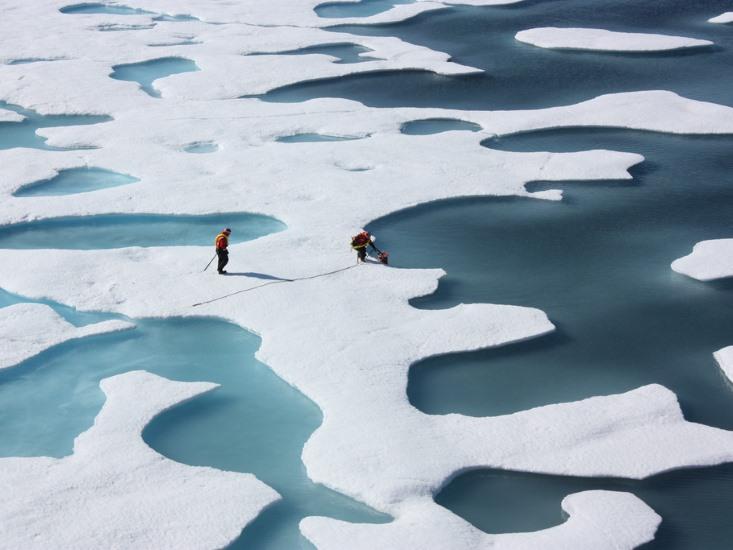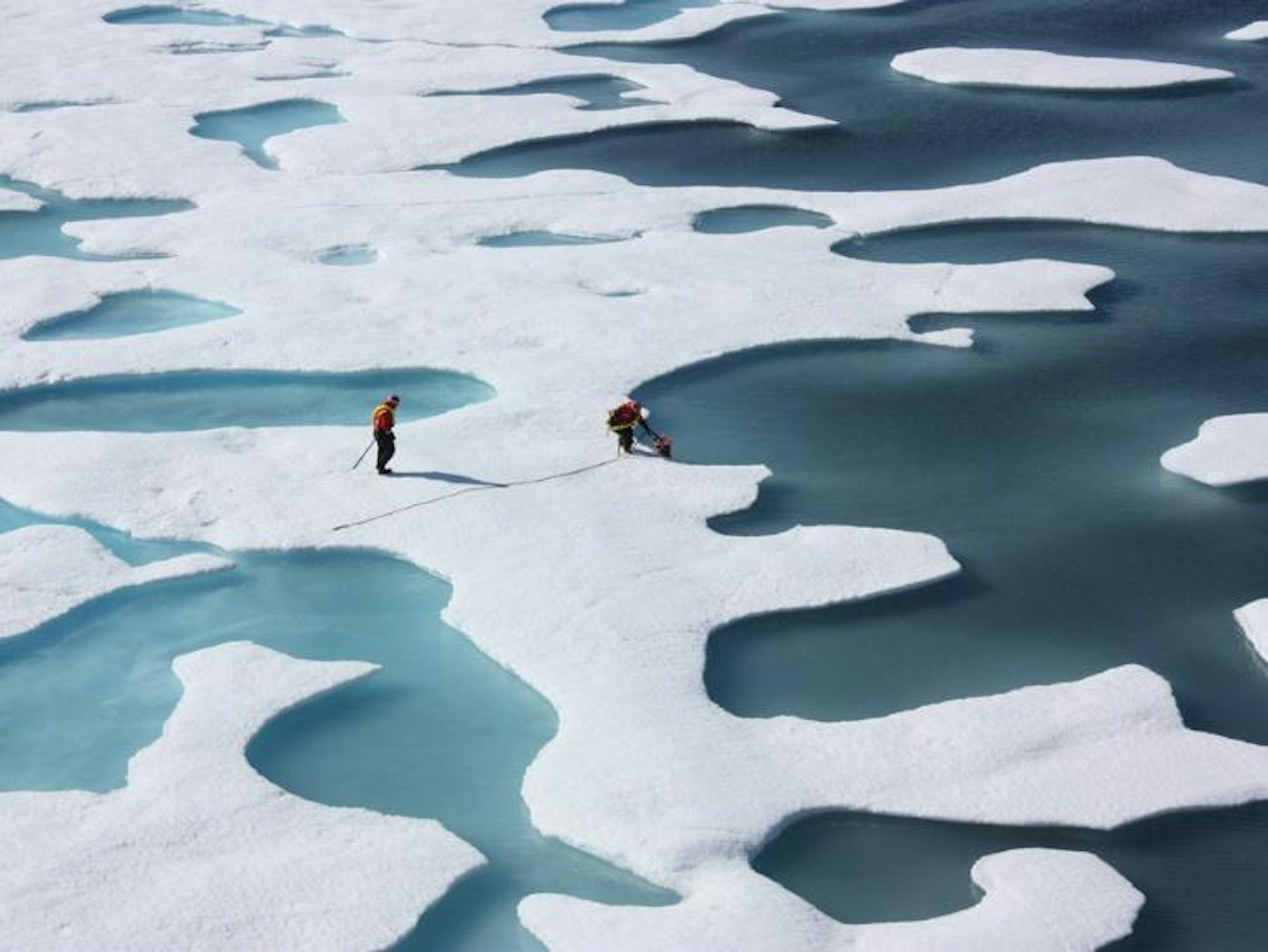
Besides a few lucky astronauts, the entire human experience is contained within a narrow envelope of gas maintained in a relatively narrow temperature range on a single rock hurtling through the vacuum of space. That temperature range depends on a delicate balance between energy entering the atmosphere, from the Sun, and energy leaving the atmosphere, radiating back out. Lucky for us, Earth has natural processes that absorb and hold onto heat to counteract that cooling effect. It is these processes that keep our little rock nice and livably warm. Without the greenhouse effect keeping heat in, Earth’s average temperature would be stuck at an untenable 0 degrees Fahrenheit instead of its actual 59 degrees.
As the world becomes hotter, some of these warming processes become stronger, leading to more and more warming. (They can also be reversed, wherein cooling leads to more cooling.) I like to think of it as the planet being thrifty, trying to get two doses of heating out of a single source. However, pushing these systems into overdrive is the main danger associated with climate change. With so much talk about fossil fuel emissions and carbon dioxide, it is easy to forget that most of the planetary warming expected from climate change will not be caused by carbon dioxide directly. Rather, as carbon dioxide—our species’ main contribution to planetary warming—builds up in the atmosphere, it will trigger “positive feedback loops.” Warming begets more warming.
These feedback mechanisms are so important to climate change that, if they didn’t exist, our carbon dioxide emissions wouldn’t be anything to worry about. In fact, without feedback loops, even if we burned enough fossil fuel to double the amount of carbon dioxide in the atmosphere, “we’d only have about a degree centigrade of warming from that, nothing anyone would be concerned about,” says Brian Soden, a climate scientist at the University of Miami. “It’s all these other feedback systems that are built into the climate system that take that one degree of warming and amplify it to four degrees”—twice the amount of change that global campaigns have set as a target for climate policy. But because Earth’s climate system is so complicated, with so many interrelated effects, it’s difficult to tell exactly how strong these feedback effects are.
So what are likely to be the worst positive-feedback loops?
#1: Water, Water Everywhere
File this under: “Our worst enemies are our friends.” The worst climate feedback loop is water vapor, plain old water in its gaseous form. “The most robust, best understood, best quantified and most positive feedback is water vapor,” says Alex Hall, an atmospheric physicist at the University of California, Los Angeles. “Water vapor feedback is pretty powerful; it amplifies warming by a factor of two.”
Water constantly evaporates from the ocean’s surface. In the atmosphere it condenses into clouds before it falls back to Earth as rain or snow. When it’s in the atmosphere, water vapor is a greenhouse gas more powerful than carbon dioxide. It absorbs heat and radiates it in all directions, sending some of that heat back down to the Earth’s surface.
You won’t typically find water vapor on lists of “worst greenhouse gases” because no individual H2O molecule remains in the atmosphere for very long. But the atmosphere sucks up as much water vapor as it can at any given time—and how much water vapor it can hold depends on temperature. The warmer the atmosphere gets, the more water vapor it can hold, which makes for an even warmer atmosphere. A positive feedback loop.
The water vapor feedback loop doesn’t have a tipping point beyond which it gets suddenly worse; it steadily gets stronger as the temperature goes up. “We have a ready supply of water vapor: 70 percent of the Earth is covered by water,” says Hall. As the atmosphere warms, the increase in water vapor responds within days to weeks. “It’s a very fast-acting process. From a climate perspective, it’s more or less in equilibrium with the temperature of the air.”
Putting water in the air is, ironically, “like throwing gasoline on a fire,” says Soden.
#2: Reflect on This
Anyone who’s made the mistake of wearing a black shirt on a hot summer day knows that dark colors absorb heat. The flipside is that light colors reflect heat for a cooling effect. More than summertime fashion advice, this effect drives another loop called surface albedo feedback.
Light-colored snow and ice reflect more sunlight than the earth and water they cover. As the climate warms, snow and ice melt, revealing more of the darker earth and water below them, which absorb more solar radiation, resulting in further warming. We can feel this in our everyday lives, even if we don’t notice it. When snow melts in the springtime, part of the warmth we feel “is related to the retreat of snow in the Northern Hemisphere and the fact that you get a lot more sunshine absorbed,” says Hall. “It’s a feedback process that you can actually observe in the seasonal cycle.”
Surface albedo feedback is strongest near the poles, which are covered in reflective snow and ice. It’s an effect that’s already happening, as we watch Arctic ice decline more and more each year. “The Arctic is the first region to have a strong detectable climate change signal,” says Hall. “So this is another feedback process that is already in play and is responsible for the patterns of climate change we’ve seen already.”
#3: Seeing (Different) Things in the Clouds
The third worst positive feedback is clouds—and part of what makes them dangerous is that their effect is unpredictable. “They have the potential to be as powerful as water vapor feedback or the potential to have zero or even negative” effects on warming, says Soden. “They’ve been a thorn in the side of climate modeling, and we really haven’t made much progress even after 30-plus years of research.”
What makes clouds so complicated is that they have two conflicting effects: Their light color reflects incoming sunlight back into space, which is why a cloud passing overhead has a cooling effect. But they are also composed of water vapor, which absorbs heat and amplifies warming. Untangling these competing effects and understanding how a warmer atmosphere will affect cloud formation is the biggest climate feedback wild card. “It’s the difference between getting two degrees of warming and four, the difference between high-end warming scenarios and low-end warming scenarios,” says Soden.
#4: Release the Carbon!
The least understood feedback mechanism is, in some ways, the most direct: A warmer world will cause ecosystems to release carbon dioxide and methane, both greenhouse gases, which will cause more warming. There are many hypotheses about specific ways this could happen: Thawing permafrost will release stored methane, which we’re already seeing as sinkholes appear across the Siberian tundra. Microbes may break down organic material more quickly, releasing stored carbon dioxide. Phytoplankton blooms may amplify warming in the ocean while ocean acidification reduces their production of cloud-forming particles. Drought may cause forest fires, which both send carbon to the atmosphere and reduce forest cover. The list goes on; in each case, more atmospheric carbon drives more warming.
Of these, permafrost carbon release has the potential to drive the most powerful feedback. A new study in Nature Climate Change estimates that more than 1 trillion metric tons of carbon lies trapped in Arctic permafrost; compare that to the 520 billion metric tons of carbon released by people since 1750. The possibility that warming temperatures could trigger the rapid release of all this carbon (as both carbon dioxide and methane) and cause runaway climate change is called the “clathrate gun hypothesis.” However, the new study suggests that this carbon will leak slowly from the permafrost over centuries rather than in a dramatic sudden release. The authors estimate that, by 2100, 5 to 15 percent of this carbon will be released from the permafrost—far less carbon than we will release from burning fossil fuels, but too much to ignore.
Working out how such additional carbon release will impact warming is the front line of climate research today. “We are just now beginning to develop models where these things can be part of climate change projections,” says Soden. “None of these will be a significant negative feedback; if anything they will all be positive feedbacks that will amplify the magnitude of the warming.”






























